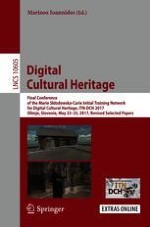2018 | Buch
Digital Cultural Heritage
Final Conference of the Marie Skłodowska-Curie Initial Training Network for Digital Cultural Heritage, ITN-DCH 2017, Olimje, Slovenia, May 23–25, 2017, Revised Selected Papers
herausgegeben von: Marinos Ioannides
Verlag: Springer International Publishing
Buchreihe : Lecture Notes in Computer Science
